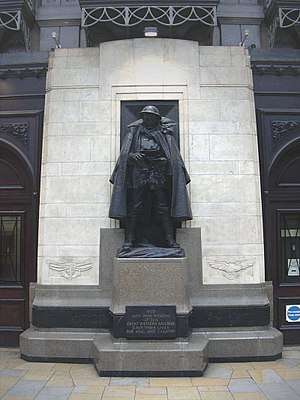Great Western Railway War Memorial
The Great Western Railway War Memorial is a monument on platform 1 of London Paddington station, dedicated to the memory of employees of the Great Western Railway who died during the First World War. The stonework was designed by the architect Thomas S. Tait, and the bronze figure by the sculptor Charles Sargeant Jagger; the memorial was unveiled on Armistice Day in 1922 by Viscount Churchill.[1]
| Great Western Railway War Memorial | |
|---|---|
| United Kingdom | |
 GWR War Memorial, platform 1, Paddington | |
| For employees of the Great Western Railway who gave their lives during the First World War | |
| Unveiled | 11 November 1922 |
| Location | 51.51713°N 0.178172°W near |
| Designed by | |
Its dominant feature is a large bronze statue of a British First World War soldier dressed in battle gear, wearing a helmet, woollen scarf, and a greatcoat draped over his shoulders. The soldier is looking down, reading a letter from home.
On the stone surround are two stylised reliefs of the emblems of the Royal Navy (rope and anchor) and the Royal Air Force (eagle in flight). Inside the plinth was placed a sealed casket, which was made at the GWR's Swindon Works, containing a vellum roll upon which was inscribed the names of the 2,524 men who gave their lives.[1]
To commemorate the founding of the Army Post Office Corps in 1882, its successor the Royal Engineers (Postal & Courier Services), commissioned Jill Tweed and Mike Smith to sculpt a life-size statue of the Great Western Railway War Memorial.[2] The statue entitled Letter from Home was unveiled at Inglis Barracks, Mill Hill, London on 16 July 1982 by Queen Elizabeth II.[3] In 2007 the statue was moved to RAF Northolt.
In 2014, as part of the First World War centenary commemorations, Jagger's GWR Memorial was featured – uncredited – in a project, "Letter to an Unknown Soldier", which invited members of the public to write a letter to the serviceman portrayed by the statue.[4] It also featured in 2014's Talking Statues initiative.
Inscriptions
The Inscriptions on the plinth read:
IN HONOUR OF THOSE WHO SERVED IN THE WORLD WARS
1914 † 1918 1939 † 1945 3312 MEN AND WOMEN OF THE GREAT WESTERN RAILWAY GAVE THEIR LIVES FOR KING AND COUNTRY. THE NAMES OF THOSE WHO GAVE THEIR LIVES ARE INSCRIBED ON A ROLL OF HONOUR DEPOSITED BENEATH THE BRONZE FIGURE.
Inside the waiting room behind the memorial is a plaque marking the unveiling of the memorial, which includes the inscription:[5]
THE GREAT WESTERN RAILWAY WAR MEMORIAL
ON PLATFORM No 1 IMMEDIATELY OUTSIDE THIS ROOM WAS UNVEILED ON ARMISTICE DAY, SATURDAY, NOVEMBER 11TH 1922
BY THE RT. HON VISCOUNT CHURCHILL, G.C.V.O. AND DEDICATED BY HIS GRACE THE ARCHBISHOP OF CANTERBURY.
THE BRONZE FIGURE WAS EXECUTED BY MR. C.S. JAGGER, M.C., R.B.S. AND THE ARCHITECTURAL WORK BY MR. T.S.TAIT A.R.I.B.A.
Images
 The memorial
The memorial The soldier reading his letter
The soldier reading his letter Inscription detail
Inscription detail Inscription detail
Inscription detail Jagger's signature on the plinth
Jagger's signature on the plinth Jagger's signature on the plinth
Jagger's signature on the plinth Detail - air force emblem
Detail - air force emblem Detail - naval emblem
Detail - naval emblem The memorial on Remembrance Sunday, 2012
The memorial on Remembrance Sunday, 2012
References
- "'Great Western Railway War Memorial'". Institute of Railway Studies. from The Great Western Railway Magazine, December 1922, pp. 537–40. 1 November 2001 [December 1922]. Retrieved 14 February 2015.
- "Letter from Home". PCS Branch Royal Engineers Association. Archived from the original on 24 September 2015. Retrieved 29 August 2015.
- "Court Circular." Times [London, England] 17 July 1982: 10. The Times Digital Archive. accessed 28 August 2015
- "Letter to an Unknown Soldier". Retrieved 1 August 2014.
- English Heritage. "War memorial, Paddington Station". Retrieved 5 November 2007.
See also
- Statue of Paddington Bear, another monument in Paddington station
- Great Eastern Railway World War I Memorial
- Royal Artillery Memorial
External links
| Wikimedia Commons has media related to GWR War Memorial. |
- Conservation of the Paddington War Memorial – Rupert Harris Conservation
- History of Paddington Station – Crossrail
- War memorial, Paddington Station – English Heritage
- War memorial Paddington Station – Geograph
- Great Western Railway War Memorial – York University Institute of Railway Studies and Transport History